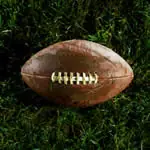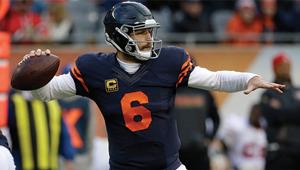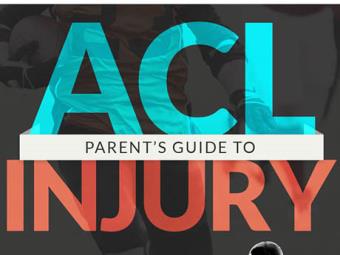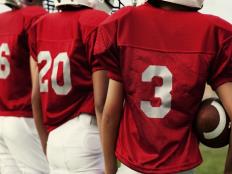
New to football? You'll soon learn that you have a lot of catching up to do.
The United States' most popular sport is full of quirky descriptions and unique terms that only veteran fans, coaches, announcers and players can understand.
But don't get frustrated. Everyone had to learn them at some point. It's not too late for you.
Here is an A-to-Z guide of the gridiron, 26 terms that are, for the most part, unique to the sport of football and understood only by those who have been around the game for a while.
Commit these to memory. Then, when the water cooler talk begins about the big game, you can fit in a little better--and be well on your way to being a die-hard pigskin fan:
Audible: After a play is called on the sideline, a quarterback can change the play after the offense is set up depending on what he anticipates the defense doing. The quarterback will often shout the change to all of his teammates before starting the play so everyone is on the same page.
Blitz: When an unusual number of defensive players, usually linebackers, go after the quarterback throwing the ball rather than staying in the backfield waiting to see where the quarterback throws it. A blitz is a high-risk, high-reward strategy for defenses.
Coffin Corner: Often referred when a punter kicks the ball out of bounds between the opponents' end zone and 5-yard line. It is named "coffin corner" because of the difficulty of the punt and the fact that the offense has to start backed up by its own end zone, which can lead to further problems.
Dime: A type of defensive formation where six defensive backs are used instead of the normal four. Dime packages are used only in obvious passing situations to maximize coverage.
Encroachment: When a defensive player crosses the line of scrimmage and makes contact with an offensive player before the play begins. Encroachment often occurs when a defensive player tries to anticipate when the ball is going to be snapped and rushes too early.
Fair Catch: During a kick or a punt, the return specialist can signal for a fair catch and be allowed to catch the football without the threat of being tackled. If a fair catch is signaled, a returner cannot advance the ball past the spot where he caught it.
Gunner: A special teams player who often lines up near the sideline and is trained to race downfield after a kick or punt and tackle the return specialist as quickly as possible.
Horse Collar Tackle: A type of tackle where a defender catches the ball carrier from behind, grabs them by the collar of their jersey and pulls them backward to the ground. The method was banned in the NFL due to several leg injuries, most notably to star receiver Terrell Owens.
Interception: When a defensive player catches a ball intended for an offensive player. An interception results in a change of possession.
Jacked Up!: A term popularized by ESPN where a player is the victim of an aggressive tackle or block that looks painful to outsiders.
Kneel Down: A play used by a team who's winning the game late and only needs to run off the rest of the clock. When an offense kneels on the ball, there is no chance at a fumble or an interception and the clock will continue to run.
Lateral: Most commonly defined as when a ball carrier throws the ball to a teammate. A team is allowed one forward lateral (a pass) per play, but there is no limit to the number of backward laterals allowed.
Mike, Sam, Will: In a 4-3 defense (four linemen, three linebackers), each linebacker is given a moniker based on where they play. The Mike linebacker plays the middle, the Sam linebacker plays on the strong side and the Will linebacker plays on the weak side. The strong side is whatever side of the field has more offensive players lined up before a play.
Nose Tackle: In a 3-4 defense (three linemen, four linebackers), the nose tackle is the middle lineman who lines up over the offensive center.
Onside Kick: When the kicking team attempts to get the ball back during the kickoff by tapping a short kick. The kicking team can get the ball back only if the kick goes more than 10 yards, so kickers often practice kicking the ball into the ground and forcing a big bounce that covers the 10 yards and gives the kicking team a chance to gain possession.
Pass Interference: When a defensive player unfairly interferes with a receiver's attempt to catch the football. There is also offensive pass interference, when a receiver unfairly interferes with a defender's attempt to intercept a pass.
Quarterback: The player directly behind the offensive line who usually takes the snap and manages the offense. The quarterback is considered the most important player on a football team.
Red Zone: The area between the 20-yard line and the end zone, generally on the side of the field where the offense is trying to score.
Super Bowl: Perhaps the world's most famous football game, which determines the annual champion of the NFL. The Super Bowl is generally played in January or February and is widely considered the most popular sporting event in the United States.
Two-Minute Warning: When two minutes are remaining in each half, officials will stop play for teams to regroup. This has the same effect as a timeout, but it is built into the game and neither team has to use one of their three timeouts to stop play.
Unsportsmanlike Conduct: A penalty that's given when a player or team is acting unethically according to the official's judgment. It is often used to penalize excessive touchdown celebrations, but can also be called for on-field fights and other incidents.
Video Replay: In the NFL and high-level college football, officials can occasionally use replay to determine if the correct call was made on a controversial play. Video replays can be requested by the officials or by head coaches depending on the situation.
Wideout: Another term for a wide receiver, or a player who's job is to catch forward passes thrown by the quarterback.
X-Receiver: A wide receiver that lines up on the line of scrimmage out wide, often on the weak side. The terms "X" "Y" and "Z" receivers are generally used only in play calling, and are just considered "wide receivers" to outsiders.
Yard Line: The amount of distance from the nearest end zone. The 50-yard line is considered the middle of the field, and all other yard lines correspond with whatever end zone they're closest to.
Zone Defense: When a defender is responsible for a certain area of the field in pass coverage, rather than a certain offensive player.
 See more football drills & tips or find a football camp near you.
See more football drills & tips or find a football camp near you.








Discuss This Article